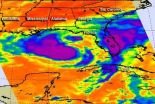(Press-News.org) Munich, Germany – August 28 2012: Improved treatment after acute myocardial infarction and less severe patient profile have reduced 30-day mortality over the past 15 years, according to research presented at ESC Congress 2012. The analysis of four French registries from 1995 to 2010 was presented by Professor Nicolas Danchin from the Hopital Européen Georges Pompidou.
Cardiologists recognize two types of myocardial infarction. The first type, ST-elevation myocardial infarction (STEMI), corresponds to the sudden, permanent occlusion of a coronary artery supplying the myocardium (cardiac muscle), usually manifesting as a prolonged, intense chest pain (what is known as a heart attack); it is a true medical emergency, as prompt reopening of the occluded artery will lead to myocardial salvage and limit the consequences of infarction. The second type, non-ST-segment elevation infarction (NSTEMI), is caused by partial or intermittent blockage of an artery, and leads to a more progressive and more limited destruction of myocardial cells; it does not usually require immediate coronary intervention.
"Over the past 15 years, the global picture of acute myocardial infarction has undergone profound changes," said Professor Danchin. "First, improvements in biological techniques have led to an easier recognition of myocardial cell death, thereby increasing the number of patients with documented myocardial necrosis (i.e. myocardial infarction) considered to have NSTEMI. Second, major changes in patient management have been implemented, following the results of numerous clinical trials in patients with myocardial infarction."
Every five years since 1995 in France, nationwide surveys of patients admitted to intensive care units for acute myocardial infarction during a one-month period have been implemented. Using data from the four registries from 1995 to 2010, the researchers sought to determine: 1) potential changes in the population of patients with heart attacks; 2) changes in their management; and 3) changes in clinical outcomes.
In all, 10,610 patients participated (1995: 2,152; 2000: 2,320; 2005: 3,059; 2010: 3,079). The proportion of patients with NSTEMI (1995: 29%; 2000: 21%; 2005: 47%; 2010 44%) increased after 2000 because of the generalized use of troponin measurements to detect myocardial necrosis (see figure 1). "Previously these patients would have been considered to have unstable angina," said Professor Danchin. "The distinction is important because unstable angina usually carries a lower risk than NSTEMI."
Mean age from 1995 to 2010 remained stable in NSTEMI patients (68 years) and decreased from 66 to 63 years in STEMI patients. From 1995 to 2010 there were increases in the prevalence of obesity (14% to 22%), diabetes (17% to 21%), hypertension (46% to 54%), current smoking (31% to 34%) and hypercholesterolemia (36% to 43%). "Overall, the patient risk profile is less severe in 2010 than in 1995 for both STEMI and NSTEMI patients, although several of the most common risk factors for developing coronary artery disease increased during this time period," said Professor Danchin.
The initial severity of infarction declined progressively, in particular with fewer patients having signs of heart failure. Professor Danchin said: "This could be because of the efficacy of primary prevention in patients with previously recognised risk factors, or secondary prevention in patients with known coronary artery disease."
Major changes in management were noted across all types of myocardial infarction. From 1995 to 2010 the use of percutaneous coronary intervention (PCI) increased from 12.5% to 65% in NSTEMI and from 19.5% to 87% in STEMI. In STEMI, the use of emergency reperfusion therapy to reopen the blocked artery increased from 49% to 75%; primary PCI increased from 12% to 60% and fibrinolysis decreased from 37% to 14%. Early use of evidence based medication increased (antiplatelet agents 91% to 97%, beta-blockers 64% to 81%, statins 14 to 90% and ACE inhibitors 46% to 60%). "This shows that the management of all patients with myocardial infarction has improved, with increasing use of recommended interventions and drug therapies," said Professor Danchin.
Thirty-day mortality dropped during 1995 to 2010 from 12.9% to 3.9% for all acute myocardial infarction patients. It fell from 13.7% to 4.4% in STEMI patients and 10.9% to 3.2% in NSTEMI patients (see figure 2). All in-hospital complications significantly decreased.
"Our analysis shows that the early mortality of both STEMI and NSTEMI patients has considerably decreased over the past 15 years," said Professor Danchin. "Our results suggest that the decreases in 30-day mortality and in-hospital complications are due to both the widespread use of coronary angiography/PCI, and earlier use of recommended medications, and the change in overall clinical presentation of the patients resulting in a decreased intrinsic risk.
###
Contributors:
N. Danchin, E. Puymirat, G. Steg, D. Blanchard, P. Goldstein, M. Hanssen, E. Durand, P. Gueret, T. Simon, JP. Cambou, on behalf of the USIK 1995, USIC 2000, FAST-MI 2005 and FAST-MI 2010 investigators
Notes to editors
Please note that picture and CV from the author, abstract, picture and CV from spokesperson can be found here.
About the European Society of Cardiology www.escardio.org
The European Society of Cardiology (ESC) represents more than 75,000 cardiology professionals across Europe and the Mediterranean. Its mission is to reduce the burden of cardiovascular disease in Europe.
About ESC Congress 2012
The ESC Congress is currently the world's premier conference on the science, management and prevention of cardiovascular disease. ESC Congress 2012 takes place 25-29 August at the Messe München in Munich. The scientific programme is available at: http://spo.escardio.org/Welcome.aspx?eevtid=54
More information is available from the ESC Press Office at press@escardio.org.
30-day mortality after AMI drops with improved treatment
2012-08-28
ELSE PRESS RELEASES FROM THIS DATE:
New method: Research team analyzes stress biology in babies
2012-08-28
After waking up, the concentration of the stress hormone cortisol in saliva rises considerably; this is true not only for grown-ups but for babies as well. A research team from the Ruhr-Universität Bochum and from Basel has reported this finding in the journal Psychoneuroendocrinology. "This gives us a new, non-invasive and uncomplicated possibility to already research the activity of the stress system during infancy," Prof. Dr. Gunther Meinlschmidt, of the Clinic of Psychosomatic Medicine and Psychotherapy at the LWL University Hospital of the RUB, said. The information ...
Ten year decline in ischemic stroke after AMI
2012-08-28
Munich, Germany – August 28 2012: The risk of ischemic stroke one year after acute myocardial infarction (AMI) dropped by 21% over a ten year period, according to research presented at ESC Congress 2012. The analysis of data from two Swedish registries was presented by Dr Anders Ulvenstam, and suggests that the reduction is due to improvements in AMI care.
Ischemic stroke is a well known, relatively rare but potentially devastating complication following myocardial infarction. It can lead to severe neurological handicap and death for the patient and it is associated with ...
Global platelet reactivity identifies high risk ACS patients
2012-08-28
Munich, Germany – August 26 2012: Global platelet reactivity is more effective than responsiveness to clopidogrel in identifying acute coronary syndrome (ACS) patients at high risk of ischemic events, according to research presented at the ESC Congress today. The results from the RECLOSE 2-ACS study were presented by Dr Rossella Marcucci from Italy.
The Responsiveness to Clopidogrel and Stent thrombosis 2 – ACS (RECLOSE 2-ACS) study is a prospective, observational, referral center cohort study of 1,789 patients with acute coronary syndromes undergoing percutaneous coronary ...
The raccoon spreads dangerous diseases as it invades Europe
2012-08-28
Furry, agile, intelligent and voracious: the raccoon is far from being a cuddly toy, which is what many people believe when they get one as a pet. It is more like an invader that escapes and is able to adapt and survive in new habitats. According to a study, its expansion across Spain and Europe is bringing infectious and parasitic diseases like rabies. This puts the health of native species and people at risk.
Originating in North America, the raccoon (Procyon lotor) is an invasive species that has established itself in Europe due to hunting and the fur trade along with ...
How 'beige' fat makes the pounds melt away
2012-08-28
The numbers of obese people are climbing steeply all over the world – with obvious major consequences for their health. Due to excess food intake and a lack of physical activity, but also due to genetic factors, the risk for overweight people dying from diseases like coronary heart disease, diabetes und atherosclerosis increases. "The body's fat reserves are actually used as a place to store energy that allows surviving lean times," says Prof. Dr. Alexander Pfeifer, Director of the Institute of Pharmacology and Toxicology of the University of Bonn. "But nowadays, hardly ...
Capturing movements of actors and athletes in real time with conventional video cameras
2012-08-28
This press release is available in German.In the computer graphics (CG) animated comedy "Ted," which is running now in the cinemas, Ted is a teddy bear who came to life as the result of a childhood wish of John Bennett (Mark Wahlberg) and has refused to leave his side ever since. CG Animated characters like "Ted" have become a standard of Hollywood's movie productions since the blockbuster "Avatar" with its blue-skinned computer-animated characters won three Oscars and brought in three billion US dollars, digital animated characters have become a standard of Hollywood's ...
ESC Acute Cardiovascular Care Association launched
2012-08-28
ACCA was previously the ESC Working Group on Acute Cardiac Care. Today it becomes one of six ESC Associations, whose presidents are invited to ESC Board meetings. "It will be easier to inform the ESC Board about the activities of the association," said Professor Christiaan Vrints (Belgium), outgoing chairman of the Working Group on Acute Cardiac Care. "We will also have a bigger impact on the policies and the development of the ESC as an organisation."
The Working Group on Acute Cardiac Care had the largest and fastest growing membership of ESC working groups. Over the ...
Study of tribe could help find East Asian skin color genes
2012-08-28
Genetic investigation of a Malaysian tribe may tell scientists why East Asians have light skin but lower skin cancer rates than Europeans, according to a team of international researchers. Understanding the differences could lead to a better way to protect people from skin cancer.
While the genetics of skin color is largely unknown, past research using zebrafish by Penn State College of Medicine's Keith Cheng, M.D., Ph.D., identified the gene in Europeans that differs from West Africans and contributes to a lighter skin color. Mutations in the genes SLC24A5 and SLC45A2 ...
Trudeau researchers identify unforeseen regulation of the anti-bacterial immune response
2012-08-28
Saranac Lake, N.Y. – August 28, 2012 — New research from the laboratory of Dr. Andrea Cooper at the Trudeau Institute, just published in the European Journal of Immunology, holds promise for the improved prevention and treatment of bacterial infections and the life-threatening complications of chronic inflammation that can result from them. The publication title is "Nitric oxide inhibits the accumulation of CD4+CD44hiTbet+CD69lo T cells in mycobacterial infection".
Following a typical bacterial infection, the immune response is manifested by the accumulation of immune ...
NASA watching Issac's approach to US Gulf Coast
2012-08-28
VIDEO:
An animation of satellite observations from August 26-28, 2012 shows Tropical Storm Isaac moving past the Florida Keys and into the Gulf of Mexico, nearing landfall in the U.S. Gulf...
Click here for more information.
NASA satellites have been providing valuable data to forecasters at the National Hurricane Center watching the development and progression of powerful Tropical Storm Isaac as it heads for landfall.
The Moderate Resolution Imaging Spectroradiometer ...



